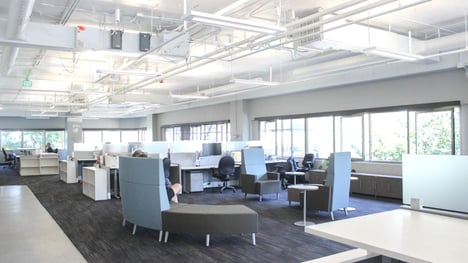25 years ago, Apex Facility Resources was founded by Marlaine McCauley to provide used and refurbished office furniture to the greater Seattle area. Our first project was providing remanufactured Steelcase 9000 panels to divide space in King County Department of Public Health’s new office in downtown Seattle. The County had a true “shock and awe” experience: moving over 300 people from their private settings in enclosed offices to an open plan across three floors while re-using all their original furniture. We sourced used panels, re-covered them with new fabric, and delivered and installed them to divide the space on all floors.
 Today there seems to be an emphasis on being “sustainable” in the office. This is more difficult than you might imagine for several reasons. Most impactful is that workspace planning styles have changed dramatically in the past 10 years. Workstation dimensions have been reduced by 50% and space division has been removed to accommodate the open plan. This change is largely impacted by the evolution of technology reducing the need for worksurface space and paper storage. With workstation size reduction and data storage in the cloud, workstation furniture from the past is now obsolete. I read that the EPA (Environmental Protection Agency) estimated that 8.5 million tons (17 billion pounds) of office assets end up in the landfills annually, and this was in 2018!
Today there seems to be an emphasis on being “sustainable” in the office. This is more difficult than you might imagine for several reasons. Most impactful is that workspace planning styles have changed dramatically in the past 10 years. Workstation dimensions have been reduced by 50% and space division has been removed to accommodate the open plan. This change is largely impacted by the evolution of technology reducing the need for worksurface space and paper storage. With workstation size reduction and data storage in the cloud, workstation furniture from the past is now obsolete. I read that the EPA (Environmental Protection Agency) estimated that 8.5 million tons (17 billion pounds) of office assets end up in the landfills annually, and this was in 2018!
From the beginning, we have successfully solved many of our clients’ workspace needs with remanufactured and used products. One of our largest projects was replacing 25-year-old Knoll Zoft workstations with remanufactured Herman Miller Ethospace. This project included the phased relocation of 750 employees to and from the swing space, disassembly and disposition of the Knoll product, and the delivery and installation of the remanufactured Ethospace workstations. This all occurred in tandem with the carpet being replaced and low voltage updates. This project was a huge win for the customer, who saved nearly $3,000,000 and simultaneously took our business to the next level. All in a time before concerns about the carbon footprint and sustainable practices were common.
Over time, import workstation products became more viable, many of them “cloning” the leading manufacturers’ largest install base nationwide (Herman Miller AO2 & Steelcase 9000). As these product solutions became more affordable, available, and reliable, the import manufacturers became an alternative to used and remanufactured furniture solutions. Considered “fast followers” in the industry, they began to improve the original products they were cloning and released more simplified and affordable systems products. The emergence of the imported product better met the demand for smaller workstation footprints and work areas.
Today we see flexible workspace strategies, wellness, and ESG (Environmental, Social, and Governance) trends pushing manufacturers to deliver low carbon, sustainable product solutions. The result is a resurgence of “greenwashing” in the office furniture industry; many of these “carbon neutral” products still require fossil fuels and energy for sourcing, manufacturing, and delivery. Many manufacturers market their products as 98% recyclable, but the reality is that the cost to handle, ship, and manage the “recycling” of these products by far exceeds any chance of someone paying for it so the claim is one of the most misleading in the market. The truth is that the commercial office furniture industry has little chance of becoming truly carbon-neutral or “sustainable” any time soon. However, manufacturers have made progress in many categories: leveraging sustainable energy (solar), Lean Manufacturing, Forest Stewardship, low/no VOC materials (volatile organic compounds), recycling waste materials, and more. Since workstation planning styles continue to evolve to a smaller footprint, resource reuse has been more difficult if not impossible. The problem is that the customer is unwilling to pay for sustainability and the manufacturers need to be profitable to survive.
All hope is not lost; there are still ways we can reuse resources as a viable option to deliver sustainability to the industry. This requires not only our architects and designers to think outside of the box, but also increasing access to viable used furniture solutions! Unfortunately, most workspace planners do not have the training, access, or time to include used furniture in their new office designs. In addition, most office furniture dealers do not have the service capabilities or the business model to support delivering a blended furnishing solution.
 Ultimately the customer needs to be willing to invest in the process and this is difficult when we are all trying to attract employees back to the workspace. My hope is that sustainability efforts can be promoted as an incentive for workspace Wellness/LEED certification as it diverts from our landfills and reduces energy use.
Ultimately the customer needs to be willing to invest in the process and this is difficult when we are all trying to attract employees back to the workspace. My hope is that sustainability efforts can be promoted as an incentive for workspace Wellness/LEED certification as it diverts from our landfills and reduces energy use.



